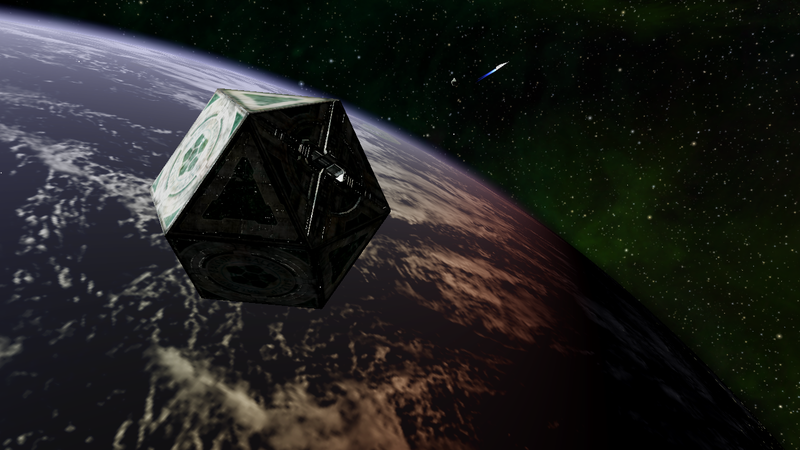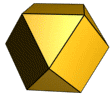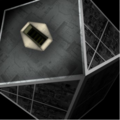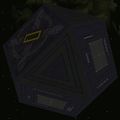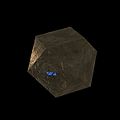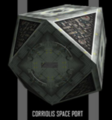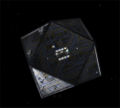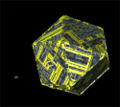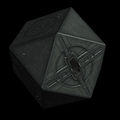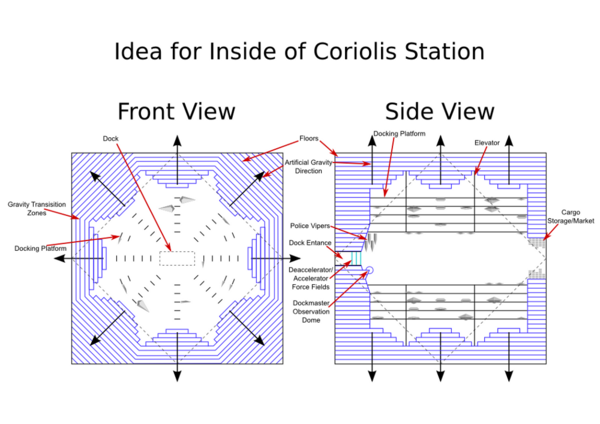Coriolis Station (Oolite)
| Coriolis Station | |
|---|---|
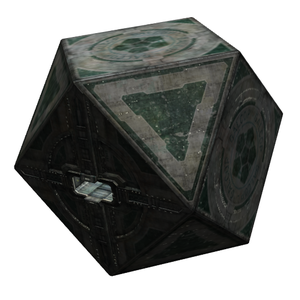
| |
| Size (metres, W×H×L) | 1000 x 1000 x 1034 |
| Manoeuvrability | Roll: 8.0 Pitch: 8.0 |
| Rotating | Yes |
| Energy recharge rate | 100 |
| Armaments | None |
| Defenders | GalCop |
| OXP or standard | Standard |
| Beacon | N |
Contents
Overview
The first operational Coriolis station was seen in orbit around Lave in 2752, presenting the uniform standard of GalCop space ports for years to come. Designed at the GASEC (Galactic Astronautic and Space Exploration Center) laboratories at Vetitice (around which the semi-functional prototype still orbits) it represented a milestone in space habitat achievement. As previous, far more vulnerable old-school designs were proven surprisingly inferior, and the economic strength of the Galactic Co-operative flexed its new muscles, an unprecedented boom across the known galaxies saw Coriolis stations simultaneously constructed in massive numbers.
Design
Though Coriolis stations are by laymen referred to as 'hexagonal in approximate shape', they are in fact cuboctahedra. How the designers initially came to discover the superior solidity inherent in this geometric shape is only speculation, but there is little doubt that their course was staked by the scientific trend of exploring geometric simplicity that signify those times. One unlikely account concerning the Coriolis' conception contends it was a GASEC janitor who presented a model of his own to a scientist in an heated argument over the designs, shouting "cause if it's got movable parts, it's liable to break!"
The shift in space station science that inevitably came about would later influence the Dodecahedron station and Icosahedron station designs. Later structures like the Torus station would abandon this tradition for dubious reasons.
The Coriolis stations landing dock size is the standard; 192m x 64m x 250m (WxHxL)
See lengthy descriptions from the Dark Wheel & Imprint in Coriolis Station (Classic).
Variants
As the Coriolis stations became 'common sight' in the 8 Galaxies, local developers started to develop more variants. It was often the case that certain life-forms needed adaptations or the stations where altered for artistic reasons. See analysis here: P.A. Groove Stations backgrounds
Politics
Attempts by planetary governments to claim sovereignity over its space ports have rarely been successful, as GalCop has enforced a strict policy to maintain joint station custody, which in effect places it under GalCop authority. By law, a Coriolis or any other GalCop station is politically neutral territory.
Habitat
Being the oldest stations, Coriolis station societies are known to often display wide varieties of humanoids and their well-established cultures, who find the gravitational and respiratory conditions fit for living.
Custom Paintjobs
Phantorgorth's Coriolis Interior
Amaranth wrote:
Clever idea but...I think you would need the floors to be circular in profile, otherwise there would be some awkward off-grav sections near the joins (the gravity would be 22.5 degrees out near these points). Bear in mind that the gravity is produced using rotation only, so it would operate radially from the axis of rotation. I imagine a coriolis in some ways to be fairly like (front section only of) Babylon 5 for how it 'works' .
Phantorgorth replied:
If you look more carefully you will see that I have taken that into account with the use of artifical gravity (big black arrows) and references to Gravity Transition Zones. Yes the station is spinning but that would only just reduce the amount of energy spent on artificial gravity. If it wasn't for the artificial gravity the floors near the axis would have low "gravity".
Selezen wrote:
The Dark Wheel describes a Coriolis thus: "Alex checked out of the ship's berth and took a sky taxi across the void. The tiny automatic ship slid delicately and smoothly between the incoming and outgoing ships. Alex watched in fascination as the towering buildings of South City dropped away below and the grey sky edged closer. To his left, he could see the pattern of streets and parklands on the inhabited plane known as Commander City. Facing the entrance to the station, on that particular level lived the high ranking officials and various planetary envoys and ambassadors. They enjoyed a landscape which included lakes, rivers and ski-slopes with real snow. Below him, the Nemesis became a tiny dart-shape on the broad landing pad. Above him, the towering offices and living blocks reached down towards him like geometrical stalactites. There was an abrupt moment's disorientation and suddenly the roof was the ground and now the Nemesis was a single, winking light in the heavens. The taxi dropped swiftly to street level, between the grey and black monolithic structures. Lights of different colours blinked and shone, and when the atmosphere began, a strange dusty shimmer seemed to envelop the city." Since that content is regarded as "canon", it doesn't fit too well with the layout you've posted. Don't get me wrong, I think your layout is damn good (so well done).
Phantorgorth replied:
It's been a very long time since I read The Dark Wheel and I didn't remember that at all. What I will say is that my diagram is just suggestive and was more an exercise in "logical" parking layouts and other details. Given that the station is meant to be a kilometre across my floors shown would really be about 8 stories tall. There is no reason you could not have a cityscape-like layout. I chose a simple pyramid layout to suggest those surfaces would not be flat but would give as many views of the central space from windows, balconies, etc. Also you get less issues as you reach "corners". Given that I am assuming the existence of gravity control technology, having the facing wall a surface with a landscaped parkland is again not out the question. Thought I imagine due to the surface on that face being at right-angles to the axis of rotation it would be at a high energy cost. Also at a kilometre across (well a bit less on the inside) I doubt that there would be room for "lakes, rivers and ski-slopes". Maybe the Coriolis discussed in The Dark Wheel is larger than normal. It certainly feels that way from the descriptions in that passage. I chose to have the centre of that face as a container yard because without gravity control that area would have very little "gravity" from centrifugal/inertial force so it made a sensible location for something not requiring gravity (i.e. cargo). Also it has easy access to the ships for loading and unloading. (I imagine lots of container shifting robots darting between the ships parked and those coming and going.) Another thought is that these stations are built to order and separated over long periods of time so there is no reason to expect the inside of one Coriolis station to be exactly the same as the next. And of course there is the idea that we don't have to be tied to any sense of "canon". It is every person's game as they want it.
Link: Discussion on Phantorgorth's interior (2013)
Links
See also:
OXPs
- BGS adds a docking sequence to these stations
- HDBG - for graphics of the lounge (resource for other OXPs such as Docking Fees)
- Life in the Frontier - adventures in the Orbital Station (unfinished, but works)
Inspiration
- Starship/Orbital Station Geomorphs a pdf download (2021)
- The Dark Wheel Classic Elite novella
- Imprint Classic Elite novella
- Status Quo first novella in the Oolite Saga
- Alien Items "Official" Oolite short stories
- SimonB's musings on Coriolis interiors
- Lost in Transit (Staggerlee, 2014) PDF download linked to Oolite BB. Life of a dockworker on a Coriolis station.
Retextures
- Z-GrOovY System Stations oxp
- Accessories oxp - other new textures for stations
- Deepspace Ships oxp also contains station textures
- Shady Sungs oxp also contains station textures
- Neolite Ships oxp also (where?) contains station textures
- Gritty Coriolis OXP was probably the earliest retexture (by Xaotik, Feb 2006 or earlier)
- P.A. Groove Stations OXP has 6 new textures for the Coriolis
- Coriolis (burning) - a burning coriolis for use in other .oxp's (2008 vintage)
